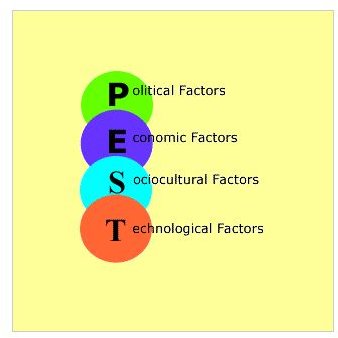PEST Analysis Examples and Methodology
What is PEST Analysis?
PEST analysis is a methodology that classifies effects of the environment as political, economic, social, and technological features. A study of the PEST analysis method and examples related to this technique is beneficial for the growth of any organization. Often the factors of legal and environment are included to modify the term to PESTLE analysis. PEST analysis considers the influence of these factors on the business. The results of this analysis are useful for obtaining the benefit of opportunities, and consequently prepare contingency plans for the imminent threats. PEST analysis is considered to be a valuable strategic method to anticipate the market decline or growth, business status, potential for improvement, and develop future operational strategy. PEST analysis ensures that the organization is functioning in accordance with the dominant influential change forces that may affect the environment of business. PEST is especially beneficial when an organization plans to enter new markets or other countries. The utilization PEST analysis assists to efficiently adjust to new environments.
Elements of PEST
While performing your analysis, it is essential to evaluate all PEST elements since these are important to ascertain the business strategy. PEST consists of the following: Political: Politics has a significant impact on the control of business, and the consumer capability of expenditures. The following should be considered while analyzing this element:
[caption id="" align=“aligncenter” width=“600”]
- Political stability in the environment.
- Influence of government policies that control the business.
- Government directions regarding market ethics, and consumer protection.
- Government economic policies.
- Influence of government on religion and culture.
- Involvement of government in trade agreements.
- Laws of employment.
Economic: Market analytics should examine the short and long term state of the business. This is particularly important while forecasting international markets. The following are important to consider:
- Rate of interest.
- State of inflation.
- Per capita income.
- Gross Domestic Product (GDP).
- Economic progress trend.
- Rate of exchange.
- Consumer confidence and its affect on aggregate demand.
- Production level.
Social: The social factors influence the business at various levels, and need to be carefully examined. These factors are:
- Leading religion.
- Attitude towards foreign goods and services.
- Influence of language on use of products in the markets.
- Time available with the consumers for leisure.
- Role of women and men in the society.
- Opinion of people on green issues.
- Demographics of the population.
- Lifestyle, education, health, fashion trends, earning capacity.
Technology: Technology is commonly identified as an essential element of the organization since it is a useful tool for the attainment of market advantage. Technology can be used, and this is affected by government support. Technological advancement can produce new industries, and also provides valuable input to service and manufacturing industries. The following are important features in this regard:
- Does technology permit the manufacture of products at economical rates, without compromising quality?
- Do the technologies present original products, like mobile telephone, internet banking, the purchase of books through internet, etc.
- Modern communication channels, like Customer Relationship Management, banners, etc.
Image Credit: re7an.net
PEST Analysis of Pepsi
The PEST analysis method has been successfully applied by Pepsi, which has obtained economic advantage in its industry. The PEST analysis method and examples specific to Pepsi are seen in the following factors: Political: The manufacture, delivery, and use of numerous Pepsi products are subject to many federal regulations, like the Food, Drug and Cosmetic Act. The business is also governed by government and foreign rules. The international business is subjected to the political stability. Economic: The products of Pepsi are influenced by the raw material yield being used in the soft drinks, juices, etc. All distribution is affected by the cost of fuel. Operations in international markets involve the study of unpredictable changes in foreign exchange rate. The economic impacts of such movements are serious because these affect the growth. Pepsi is also subjected to availability of energy, supply of money, business cycles, etc. Social: Lifestyle has great influence on the use of Pepsi products, and their advertisements are designed accordingly. Introduction of Pepsi products in the international market requires an in depth study of the local social structure. Technology: Pepsi is influenced by the modern manufacturing techniques applicable to their business divisions of soft drinks, juices, and snack food. Pepsi has to focus on the latest distribution techniques, and other technological advances in their industry.
References
“PEST Analysis.” Marketing Teacher. (accessed December 24, 2010).
